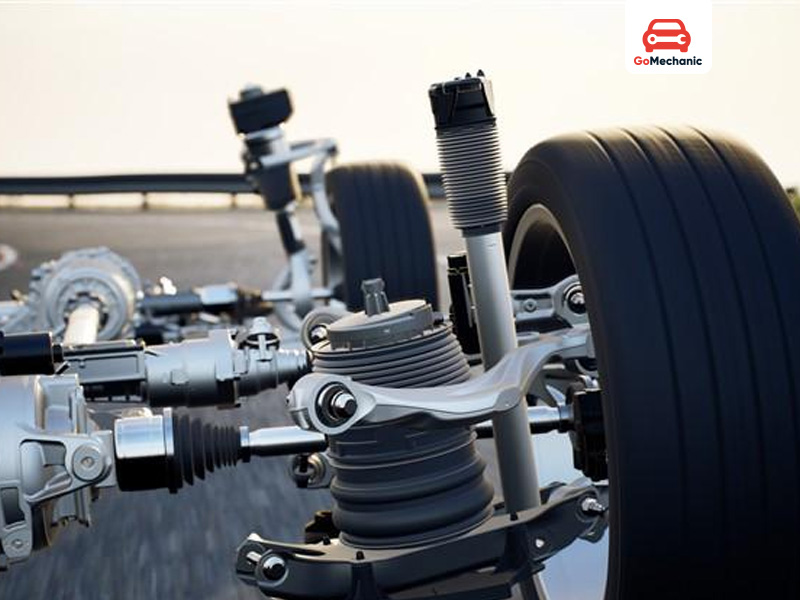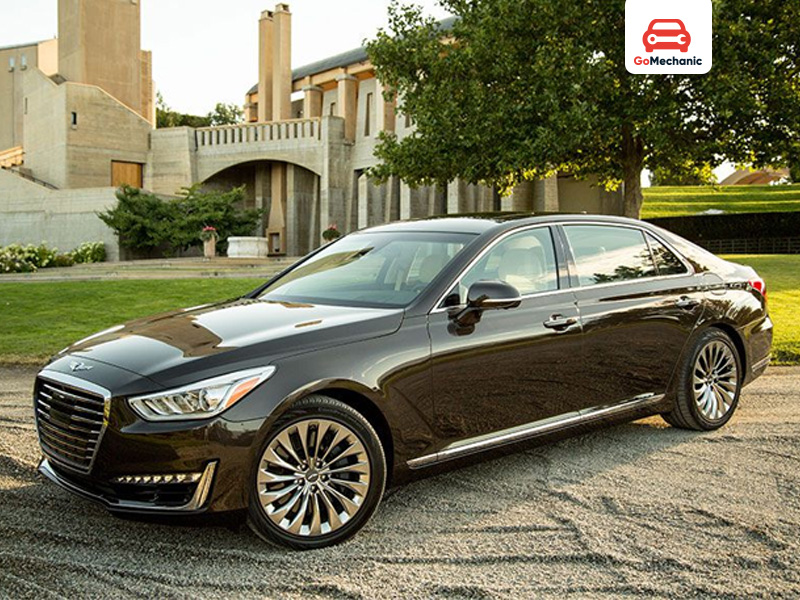Smooth. Adaptive. Intelligent. That’s what an air suspension system delivers.
Luxury sedans. Performance SUVs. Heavy-duty trucks. Built to carry. Engineered to endure. They all rely on air suspension. But it’s more than just absorbing bumps. It’s about control. Keeping the ride firm. Keeping it stable. It’s about efficiency. Sensing the weight. Adjusting to terrain. Adapting to every load shift in real time. It’s about adaptability. Dropping low for aerodynamics. Rising high when the road demands it.
Every drive. Every load. Every condition. It adjusts. So you don’t have to.
But what exactly is an air suspension? How does it work? What are its advantages? More importantly, Should you consider it for your car?
Read this blog to get answers to your queries.
What is Air Suspension?

Forget springs. Forget coils.
Air suspension changes the game. Steel out. Air in. It replaces traditional coil or leaf springs with air-filled bags—air springs. Made of rubber. Made of plastic. Built to adapt. An onboard compressor takes control. It adjusts air pressure. Regulates height. Modifies stiffness. Every road, every load—it adapts, so the ride stays smooth, stable, and precise.
Every air suspension system consists of:
- Air Springs (Airbags): Soft. Flexible. They replace rigid metal springs, adapting to every bump, every load.
- Compressor: The heart of the system. It pumps air, inflating the airbags, adjusting in real time.
- Valves & Solenoids: They control the flow. More air? Less air? They decide. Keeping every airbag at the perfect pressure.
- Electronic Control Module (ECU): Tracks ride height, fine-tunes settings, and keeps everything running smoothly.
Do read: Air Suspension To Coilover Conversion: Mercedes Benz ML 350
How Does Air Suspension Work?
- Load Detection: The system detects changes in vehicle load and road conditions.
- Air Pressure Adjustment: The compressor fills or releases air from the airbags.
- Adaptive Ride Height: The ECU adjusts the car’s height based on speed and terrain.
- Smooth Ride: The suspension constantly adapts, ensuring a comfortable, balanced ride.
Air suspension isn’t just about comfort. It’s about control, handling, and customization—something traditional suspension can’t match.
Why Air Suspension? The Real Benefits
- Adaptive Comfort & Ride Quality
Unlike traditional suspensions, air suspension thinks. It adjusts in real time. More air? The ride firms up. Less air? It softens. Cushions every bump. Cruising on highways? It lowers for stability. Tackling rough terrain? It rises for clearance. Every road. Every condition. Always controlled. Always smooth.
- Adjustable Ride Height
Ever scraped the bottom of your car on a speed bump? Not with air suspension.
- At high speeds: The system lowers the car for better aerodynamics and fuel efficiency.
- On rough roads: It raises the ride height to clear obstacles.
- When parking: Some systems lower for easier entry and exit.
- Reduced Wear & Tear on Suspension Components
Since air suspensions absorb shocks more effectively, other components last longer—from shock absorbers to control arms and bushings.
- Enhanced Stability & Handling
Air suspensions minimize body roll during cornering, making high-speed driving safer. SUVs and performance sedans benefit the most, keeping them planted on sharp turns.
- Better Load Management
Carrying extra weight? Air suspensions adapt instantly. Load changes? They adjust. Extra weight? They balance it out. That’s why trucks and buses rely on them—keeping the vehicle stable, no matter how much cargo it hauls.
- Smoother Towing Experience
Towing changes everything. More weight. More strain. A trailer can throw off balance, making the rear sag, the front lift, and control suffer. But air suspension fixes that. It levels the ride. Adjusts in real time. Keeps everything balanced. More stability. More control. Less stress.
The Downsides of Air Suspension
Not everything is perfect. Air suspension has its challenges.
- Leaks & Failures Are Common
Unlike metal springs, airbags are prone to leaks. Over time, rubber components wear out, and any air leak can cause a drop in ride height or even system failure.
- Higher Maintenance Costs
- Air compressors need care. Regular servicing keeps them running. Neglect them? They fail.
- Valves, hoses, connections—everything wears. Faster than traditional suspensions. More parts. More maintenance. Stay ahead, or expect trouble.
- Repairs are expensive compared to standard coil and shock setups.
- Expensive to Install
Luxury cars. High-end SUVs. They get air suspension from the factory. Built-in. Ready to go. But adding it later? Different story. Retrofitting isn’t cheap. Custom parts. Complex installation. Costs can climb into lakhs. Think before you upgrade.
- More tech. More parts. More risks.
An air suspension system is packed with sensors, electronics, and moving components. More than a simple coil-spring setup. One small failure? One sensor glitch? It can throw off the entire system. Smooth ride one moment, costly repair the next.
- Can Reduce Fuel Efficiency
An air suspension system is heavier than a conventional suspension. While the difference isn’t huge, more weight means slightly lower fuel economy.
Also read: Air Suspension | Pros & Cons Explained
Signs Your Air Suspension System is Failing
A failing air suspension system doesn’t go unnoticed. Watch for these warning signs:
- Car Sagging to One Side
If one corner of your car sits lower than the rest, the airbag may be leaking or the compressor might be failing.
- Compressor Runs Continuously
The compressor should only run when necessary. If it never stops, it’s likely compensating for a leak somewhere in the system.
- Rough Ride Instead of a Smooth One
A bouncy, uncomfortable ride usually means airbags or shocks are worn out.
- Suspension Warning Light on Dashboard
Modern vehicles with air suspension have electronic monitors. If the system detects low pressure or an issue with height adjustment, it triggers a warning light.
- Strange Noises from Under the Car
Hissing sounds? That’s air escaping from a leak. A clicking or knocking noise? The compressor may be failing.
Notice the signs? Don’t ignore them.
A sagging car, a noisy compressor, a rougher ride—they’re warnings. Small issues today can turn into bigger, costlier problems tomorrow. Get it checked. Fix it early. Drive worry-free.
Know more: Telltale Signs Of A Failing Air Suspension
Should You Choose Air Suspension for Your Car?

Who Should Get It?
- Luxury car buyers looking for the smoothest ride.
- SUV or off-road owners who need adjustable ride height.
- Drivers who frequently tow or carry heavy loads.
Who Should Skip It?
- Budget-conscious buyers who want low maintenance costs.
- Drivers who don’t need advanced ride customization.
- Those who plan to keep their car for 10+ years (repair costs increase over time).
Bottom line? Air suspension delivers. Smooth rides. Adaptive control. Unmatched comfort. But there’s a catch. It’s expensive. It’s high-maintenance. And not always necessary. Luxury or liability? That depends on how much you’re willing to invest—in both money and upkeep.
Air Suspension: Is It Worth It?
Smooth ride. Adjustable height. Ultimate control.
Air suspension sets the standard for comfort. It softens bumps, adapts to roads, and keeps your car level under any load. Luxury cars, SUVs, and heavy haulers swear by it. But it’s costly. It needs care. Leaks happen. Repairs aren’t cheap. Ignore maintenance? Expect trouble. So, the real question—Do you need it? Or do you just want it? If comfort, precision, and ride control outweigh the costs, air suspension isn’t just an upgrade. It’s the future






Any for Mahindra bolero pickup air saspension….,?
Hey Shirijsinh,
An air suspension on a Mahindra Bolero Pickup would be counterintuitive given that the Bolero will be hauling heavy loads and leaf springs (patta) are meant just for that purpose. Moreover, and air suspension on the Bolero will ramp up the maintenance cost.
what if i want to get air suspension on a gypsy ? it is lighter and driving around is just for fun … air suspension is better ryt?
Air suspension has its pros and cons. But we do believe that they are better than conventional ones. But whether you can get them retrofitted is something you need to check, as safety and stability is integral to any car.